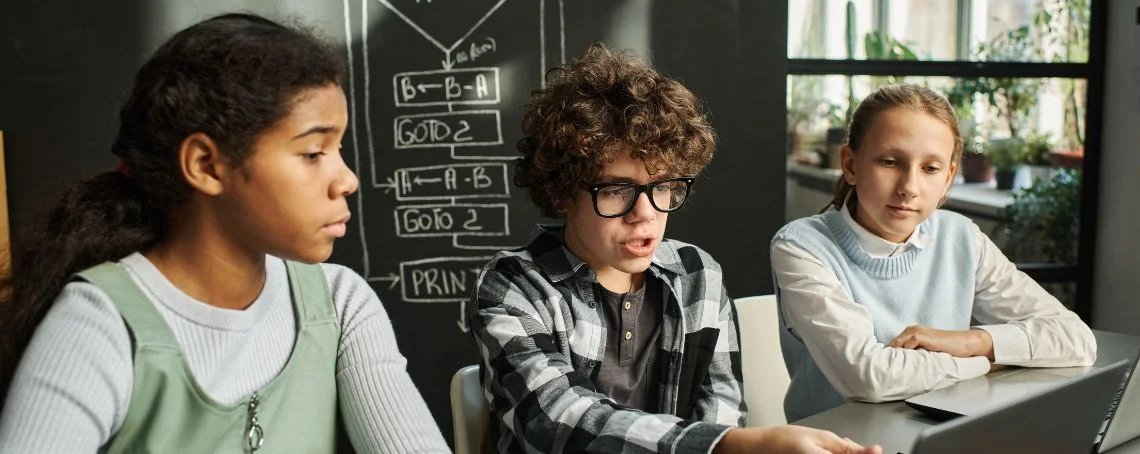Technology surrounds our children at every turn: from the apps they use to the games they play. As parents, we often wonder how to best prepare our kids for a future where programming skills are becoming as important as reading and writing.
Programming isn’t just about creating the next viral app or becoming a software engineer (though those are certainly possibilities!). Learning to code develops skills that will serve your kid throughout school and beyond.
Table of contents:
- What Is Coding for Kids?
- Why Is Coding Important for Kids
- How Early Can My Kid Start to Code?
- How to Choose the Best Coding Class for My Kid
- Common Myths with Coding for Kids Programs
- 3 Great Coding Activities for Kids
- Learn to Code with Zinkerz
What Is Coding for Kids?
Coding for kids means teaching children how computers work and how to give them instructions in a way that is fun and easy to understand. It starts with simple tools like Scratch, where kids don’t have to write code. Instead, they drag and drop colorful blocks like digital Lego pieces to tell the computer what to do. This makes learning to code feel more like playing a puzzle game..
Sarah, our Marketing Administrative Coordinator at Zinkerz, shares the basics:
As children get more comfortable and want to try new things, they can move on to typing actual code using beginner-friendly languages like Python and JavaScript.
Why Is Coding Important for Kids
There are numerous benefits to introducing kids to coding. At its core, programming fosters problem-solving skills by teaching children how to break down complex issues into manageable parts. Since code is the language behind how we interact with modern digital systems, knowing how to code gives kids insight into the technology that shapes our world. This knowledge empowers them to become creators rather than just tech consumers.
Perhaps most importantly, coding nurtures creativity and innovation. Through programming projects, children learn to turn their ideas into reality. Coding also promotes a growth mindset and resilience. The debugging process (finding and fixing errors in code) teaches kids that mistakes are a natural part of learning. This experience builds perseverance and helps students understand that challenges are growth opportunities, not roadblocks. The importance of coding will only grow as an indispensable part of modern education.
How Early Can My Kid Start to Code?
Children can begin their coding journey surprisingly early, with many starting as young as 4-6 years old. Starting with the visual blocks first makes it much easier for kids to understand how coding works before they tackle the more advanced stuff.
Around ages 7-9, kids can progress to more advanced programming and even begin exploring simple text-based coding. They can start working with coding platforms or apps that offer more sophisticated projects. With these tools, they can build their own games, create moving pictures, design apps, or even control robots.
Sarah names the steps to start coding at any age and level.
How to Choose the Best Coding Class for My Kid
The most effective coding classes combine fun, project-based learning with clear skill progression and personalized support from coding teachers.
Look for a curriculum that offers hands-on experience with real projects rather than just theoretical lessons. Students learn best when they can create tangible outcomes they can share with friends and family. The program should also provide a clear pathway from beginner concepts to more advanced programming languages and computer science topics.
Class size matters. We suggest small groups because they allow for more individual attention, enabling teachers to adapt their instruction to each student’s pace and provide personalized feedback on their projects. Live instructor support creates opportunities for real-time problem-solving and mentorship that recorded lessons cannot match.
Consider programs that integrate coding with other STEAM subjects, as well as college preparation components. This approach helps students see the broader applications of coding.
Common Myths with Coding for Kids Programs
Myths often prevent parents from exploring valuable learning opportunities for their children. Understanding the reality behind these misconceptions helps families make informed decisions about coding education. See some of the most common myths around coding for kids.
“My child is too young to code”
This is false. Many block-based platforms are designed for children as young as preschoolers, using play-based learning to build foundational logic skills. With the right, age-appropriate tools, programming concepts can be introduced in a way that feels natural and accessible to even very young learners.
“If they code early, they’ll outgrow it”
This myth misunderstands how programming skills develop. Early experiences build confidence, create a smoother transition to text-based languages, and foster familiarity with core concepts that benefit students as they progress.
“Coding increases harmful screen time”
This concern confuses passive screen use with active, educational engagement. While screen time issues often stem from endless scrolling or gaming, coding transforms screens into tools for creativity, problem-solving, and skill-building.
3 Great Coding Activities for Kids
Here are three engaging programming activities that combine learning with creativity:
- Scratch Projects
When using Scratch, kids can create simple games, animations, or interactive stories. This platform allows students to experiment with programming logic, loops, and conditional statements while building projects that reflect their interests and creativity. Scratch’s extensive libraries of sprites, sounds, and backgrounds provide rich resources for imaginative projects.
- Game Design Platforms
Platforms like Roblox Studio or Code.org’s tutorials offer interactive experiences that allow kids to design and program their own games. These tools combine programming skills with creative design, allowing students to explore both the technical and artistic aspects of game development. The activities teach programming fundamentals.
- App Development with App Lab
Code.org’s App Lab provides an excellent platform that shows kids how to create and modify mobile applications. Students can design user interfaces, add interactive features, and understand how data flows through applications. App Lab introduces more advanced programming concepts.
Learn to Code with Zinkerz
Whether your child is just beginning to explore computer science or ready to advance their programming abilities, Zinkerz provides the structured curriculum, expert instruction, and supportive community needed for coding success.
Zinkerz offers exceptional STEAM courses and coding classes, created for kids and teens. We provide a comprehensive learning experience that balances skill-building, creativity, and real-world application.
Let’s learn coding while having fun and making new friends. Book a call with us today.


